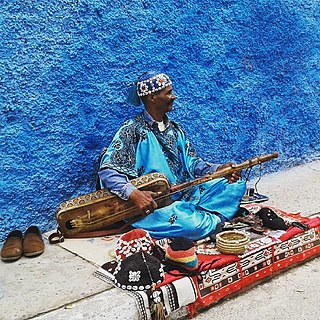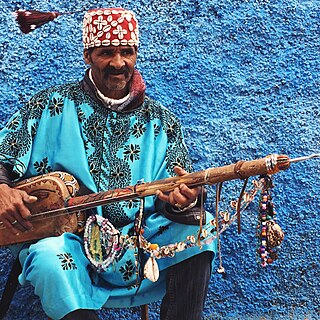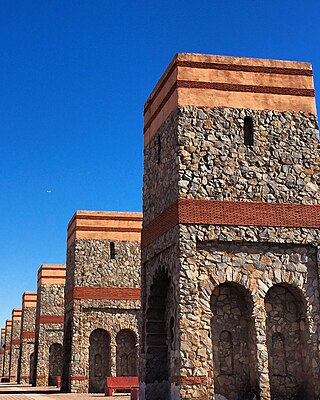A marabout is a Muslim religious leader and teacher who historically had the function of a chaplain serving as a part of an Islamic army, notably in North Africa and the Sahara, in West Africa, and (historically) in the Maghreb. The marabout is often a scholar of the Qur'an, or religious teacher. Others may be wandering holy men who survive on alms, Sufi Murshids ("Guides"), or leaders of religious communities.

Moulay Ismail Ibn Sharif, born around 1645 in Sijilmassa and died on 22 March 1727 at Meknes, was a Sultan of Morocco from 1672 to 1727, as the second ruler of the 'Alawi dynasty. He was the seventh son of Moulay Sharif and was governor of the province of Fez and the north of Morocco from 1667 until the death of his half-brother, Sultan Moulay Rashid in 1672. He was proclaimed sultan at Fez, but spent several years in conflict with his nephew Moulay Ahmed ben Mehrez, who also claimed the throne, until the latter's death in 1687. Moulay Ismail's 55-year reign is the longest of any sultan of Morocco. During his lifetime, Isma’il amassed a harem of over 500 women with more than 800 confirmed biological children, making him one of the most prodigious fathers in recorded history.

MoulayYusef ben Hassan, born in Meknes on 1882 and died in Fes in 1927, was the 'Alawi sultan of Morocco from 1912 to 1927. He was the son of Hassan I of Morocco, who was the son of Muhammad IV of Morocco.
Moroccan music varies greatly between geographic regions and social groups. It is influenced by musical styles including Arab, Berber, Andalusi, Mediterranean, Saharan, West African, and others.

Ifrit, also spelled as efreet, afrit, and afreet, plural عفاريت ʿafārīt), is a powerful type of demon in Islamic culture. The ʿafārīt are often associated with the underworld and identified with the spirits of the dead, and have been compared to evil geniī loci in European culture. In Quran, hadith, and Mi'raj narrations the term is always followed by the phrase "among the jinn". In later folklore, they developed into independent entities, identified as powerful demons or spirits of the dead who sometimes inhabit desolate places such as ruins and temples. Their true habitat is the Jahannam or underworld.

The Gnawa are an ethnic group inhabiting Morocco, that had been brought as slaves from West African Sahel, especially northern Nigeria.

Gnawa music is a body of Moroccan religious songs and rhythms. Its well-preserved heritage combines ritual poetry with traditional music and dancing. The music is performed at lila, communal nights of celebration dedicated to prayer and healing guided by the Gnawa maalem, or master musician, and their group of musicians and dancers. Though many of the influences that formed this music can be traced to West African kingdoms, its traditional practice is concentrated in Morocco. Gnawa music has spread to many other countries in Africa and Europe, such as France.

The sintir, also known as the guembri (الكمبري), gimbri, hejhouj in Hausa language, is a three stringed skin-covered bass plucked lute used by the Gnawa people. It is approximately the size of a guitar, with a body carved from a log and covered on the playing side with camel skin. The camel skin has the same acoustic function as the membrane on a banjo. The neck is a simple stick with one short and two long goat strings that produce a percussive sound similar to a pizzicato cello or double bass.
Afro-Arabs or African Arabs are Arabs of full or partial indigenous African descent. These include primarily minority groups in the United Arab Emirates, Yemen, Saudi Arabia, Oman, and Qatar, as well as Syria, Iraq, Palestine, and Jordan. The term may also refer to various Arab groups in certain African regions.

The Isawiyya is a religious Islamic mystical brotherhood founded in Meknes, Morocco, by Sheikh al-Kamil Mohamed al-Hadi ben Issa (1465–1526), best known as the Shaykh Al-Kamil, or "Perfect Sufi Master". The terms Aissawiyya (`Isawiyya) and Aissawa (`Isawa), derive from the name of the founder, and respectively designate the brotherhood and its disciples.

In the cultures of the Horn of Africa and adjacent regions of the Middle East, Zār is the term for a demon or spirit assumed to possess individuals, mostly women, and to cause discomfort or illness. The so-called zār ritual or zār cult is the practice of reconciling the possessing spirit and the possessed individual. Zār possession is often considered lifelong and the rituals associated with it are a form of adorcism, though some have falsely attributed it as an exorcism rite because it involves possession. It is similar to the Maghreb's Hamadsha, Hausa Animism, and various African Traditional religions, such as Voodou.
Sidi Abderrahman el Majdoub, also transcribed as Mejdub, full name al-Shaykh Abu Zayd Abderrahman al-Majdoub ibn Ayyad ibn Yaacub ibn Salama ibn Khashan al-Sanhaji al-Dukkali, was a Moroccan poet, Sufi and mystic. Many lines of his poems are known throughout the Maghreb, and his work is the source of many proverbs.

The Zawiya of Moulay Idris II is a zawiya in Fez, Morocco. It contains the tomb of Idris II, who ruled Morocco from 807 to 828 and is considered the main founder of the city of Fez. It is located in the heart of Fes el-Bali, the UNESCO-listed old medina of Fez, and is considered one of the holiest shrines in Morocco. The current building experienced a major reconstruction under Moulay Ismail in the early 18th century which gave the sanctuary its overall current form, including the minaret and the mausoleum chamber with its large pyramidal roof.

The Zawiya al-Nussak is a historic zawiya located just outside the old city walls of Salé, Morocco.

Sidi Yusuf ibn 'Ali as-Sanhaji is a wali who was born in Marrakesh, Morocco and died there in 1196 CE. He is considered one of the Seven Saints of Marrakesh, and one of the administrative divisions of Marrakesh is named after him.

The Seven Saints of Marrakesh or Patron Saints of Marrakesh are seven historical Muslim figures buried in Marrakesh, Morocco. Each of them was a famous Muslim judge, scholar or Sufi saint (wali) venerated for their piety or other mystical attributes. Their tombs form the basis of a centuries-old annual pilgrimage, a ziyara, during which visitors pray at each of their tombs over the course of seven days.

The Zawiyaof Sidi Abdelkader al-Fassi, also known as the Zawiya al-Fassiya, is one of the most important historical zawiyas in Fes, Morocco. It is named after Sidi Abdelkader al-Fassi, a highly important 17th-century Muslim scholar, mufti, and Sufi saint of the city who is buried in the zawiya. The building is located in the Qalqliyin neighbourhood in the south of Fes el-Bali, the old medina of Fes. It was one of several zawiya sites in the city and across the country which were associated with the al-Fassiya tradition of Sufism.

The Shaykh al-Kamil Mausoleum, romanized as Cheikh Al Kamel Mausoleum also known as the Mausoleum of al-Hadi ben Issa is a historic religious complex located in Meknes, Morocco.

Bab al-Barda'in or Bab Berdaïne is the northern gate of the historic medina of Meknes, Morocco.
Sharifism is a term used to describe the system in pre-colonial Morocco in which the shurafā' —descendants of the Islamic prophet Muhammad —held a privileged religious and political position in society. Those who claimed this lineage were regarded as a kind of nobility and were privileged, in the words of Sahar Bazzaz, "as political agents, as interlocutors between various sectors of society, and as would be dynasts of Morocco." They were additionally believed to possess baraka, or blessing power. Claiming this lineage also served to justify authority; the Idrisi dynasty (788-974), the Saadi dynasty (1510-1659), and the 'Alawi dynasty (1631–present) all claimed lineage from Ahl al-Bayt.














